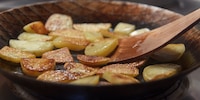
Behind the scenes
Teflon pans are on their way out
by Tobias Billeter

Non-stick coatings on pans may be handy, but they have a negative impact on the environment. As a result, the demand for alternatives has never been higher. If you’re thinking of making the switch too, there are a few key points to bear in mind.
Change is always tough. At work, a new software program suddenly replaces your fax machine. The buttons on your phone disappear, a touchscreen materialising in its place. And you don’t have to put your car key into the lock any more. Alright, we haven’t time-travelled back to 2007. What these examples do show us is that new things take some getting used to.
It’s the same story when it comes to frying pans, a product about to undergo a major change. To be exact, pans with coatings, such as those made from PTFE, are on the downward slide. As one expert described in this SRF interview (in German), PTFE, also known by its brand name Teflon, hardly breaks down at all in the environment. The substance can build up in the food chain, making its way into the human body too. This can have negative health consequences, with PTFE suspected to increase cholesterol levels and cause kidney cancer.
As a result, alternatives are becoming increasingly popular, including on Galaxus.
Update: 4 August 2025
We talked about alternatives to non-stick pans in our (Swiss-German) podcast «Uftischt». The discussion starts at 12:30…
Not only is cooking with coated pans straightforward and intuitive, but you barely need to grease them. People have become so used to enjoying these benefits that they’ve grown unaccustomed to using other types of pans. When they buy non-coated alternatives, they find themselves unable to cope. Some send their purchases back to Galaxus and ask for a refund. However, most of the time, the problem isn’t what’s on the stove, but what the person standing in front of it is doing. Since cast-iron, ceramic and stainless steel pans aren’t as easy to handle as pans with non-stick coatings, here are some tips to bear in mind.
Like PFAS-coated pans, ceramic-coated pans aren’t made to last forever. The coating loses its non-stick properties after a while, meaning you’ll end up having to replace these pans eventually. Use them incorrectly, however, and that moment will arrive even sooner.
Here’s what Swiss pan manufacturer Kuhn Rikon says you should bear in mind when using a frying pan with a ceramic coating:
To maintain them for as long as possible, you should:
… always grease the pan.
… never put the pan in the dishwasher.
… never heat the pan above 180 degrees Celsius.
If you find your pan’s starting to stick, chance are you haven’t followed one of these points.
You need a little practice before achieving decent results with a stainless steel pan. Although these pans aren’t non-stick, they’re very durable, robust and heat-resistant.
Here are some things you should bear in mind when using them:
To achieve good results, you should…
… preheat the pan for a good amount of time before frying.
… do the water drop test (check if water bubbles on the surface of the pan).
… make sure the pan’s well greased – especially when cooking protein-based foods.
When cooking with stainless steel, it’s good if the food burns a little and sticks slightly. These fried-off, caramelised bits give sauces made in the pan a flavour to die for. If the food sticks, you either haven’t preheated the pan properly or haven’t used enough grease.


Tefal Jamie Oliver Cook Smart stainless steel pan
24 cm, Frying pan, Stainless steel

Cast-iron pans are extremely durable. If you look after them properly, they’ll even improve over time. The pans don’t have any coating, but if you season them often enough, they develop a natural non-stick layer (a patina).
Here are some things you should bear in mind when using these pans:
To create and maintain this effect, you should…
… season the pan regularly.
… only clean the pan with hot water (don’t use washing up liquid).
… dry and oil the pan immediately after cleaning.
…avoid cooking acidic foods, such as any that contain wine, tomatoes or vinegar, for long periods of time.
If the pan rusts or loses its non-stick properties, you’ve either cleaned it with washing-up liquid or not dried it properly.
Enamelled cast-iron pans are easier to clean than raw cast-iron pans, but even they aren’t totally forgiving. They’re robust and store heat really well, but they don’t have a traditional non-stick coating.
Here are some things you should know about enamelled cast-iron pans:
To prevent food from sticking and make the enamel last for a long time, you should…
… heat the pan slowly.
… remember that many dishes require a little grease.
… avoid using metal utensils as these can damage the enamel.
If food sticks or the enamel chips, you might’ve heated the pan too much or used unsuitable utensils. Cleaning these pans with washing-up liquid is no problem.
I’m generally a big fan of pans that last a lifetime. I’ve had my cast-iron pan for ten years and have never had to re-season it. Meanwhile, my enamelled stewpot is over 20 years old and still doing as good a job as when I first got it. The only part of it that’s become slightly discoloured over the years is the bottom.
When I flew the family nest over 15 years ago, I suddenly had to cook for myself. But it wasn’t long until this necessity became a virtue. Today, rattling those pots and pans is a fundamental part of my life. I’m a true foodie and devour everything from junk food to star-awarded cuisine. Literally. I eat way too fast.
Interesting facts about products, behind-the-scenes looks at manufacturers and deep-dives on interesting people.
Show all